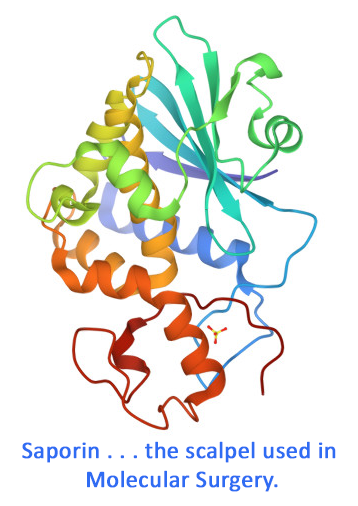Melanopsin was discovered as a novel opsin in the melanophores (light-sensitive skin cells) of the African clawed frog. It was then found that melanopsin is also present in mouse retina, specifically in ganglion cells, and that it mediates non-visual photoreceptive tasks. Melanopsin is also encoded by Opn4 with orthologs in a variety of organisms. Melanopsin-SAP specifically eliminates intrinsically photosensitive retinal ganglion cells (ipRGCs) that express melanopsin. The ipRGCs, with their amazing long processes, are involved in the perception of light and dark and are circadian rhythm determinants.
Melanopsin-SAP is a chemical conjugate of an affinity-purified rabbit polyclonal antibody to mouse melanopsin and the ribosome-inactivating protein, saporin. It specifically eliminates intrinsically photosensitive retinal ganglion cells (ipRGCs) that express melanopsin.
Melanopsin-SAP is available individually (Cat. #IT-44) or as a kit (Cat. #KIT-44) which includes Melanopsin-SAP and Rabbit IgG-SAP (Cat. #IT-35).
keywords: Melanopsin, Intrinsically photosensitive retinal ganglion cells, ipRGC, ipRGCs, Anti-Melanopsin, saporin, circadian rhythm, brain, neuroscience, retina, flat mount, cornea, eye, staining
Intrinsically photosensitive retinal ganglion cells.
Do MTH, Yau K (2010) Intrinsically photosensitive retinal ganglion cells. Physiol Rev 90(4):1547-1581. doi: 10.1152/physrev.00013.2010
Summary: This review presents recent data that has established the importance of intrinsically photosensitive retinal ganglion cells (ipRPG) in nonimage visual functions. The use of melanopsin-SAP (Cat. #IT-44) in both mice and rats is discussed. It is of note that depletion of ipRPG's using melanopsin-SAP resulted in deficits in communication to nonimage regions of the brain, but image vision appeared normal.
Related Products: Melanopsin-SAP (Cat. #IT-44)
Immunotoxin-induced ablation of the intrinsically photosensitive retinal ganglion cells in rhesus monkeys
Ostrin LA, Strang CE, Chang K, Jnawali A, Hung L-F, Arumugam B, Frishman LJ, Smith EL, Gamlin PD (2018) Immunotoxin-induced ablation of the intrinsically photosensitive retinal ganglion cells in rhesus monkeys. Front Neurol 9:1000. doi: 10.3389/fneur.2018.01000
Objective: To develop and validate a targeted ipRGC immunotoxin to ultimately examine the role of ipRGCs in macaque monkeys.
Summary: Findings demonstrated that Melanopsin-SAP was specific for ipRGCs, and induced a graded reduction in the PLR (pupillary light reflex), as well as in ipRGC-driven pupil response with concentration.
Usage: Solutions of 0.316, 1, 3.16, 10, and 50 μg delivered intravitreally.
Related Products: Melanopsin-SAP (Cat. #IT-44)
browse all references for this product | back to top


Reviews
There are no reviews yet.